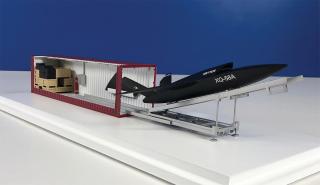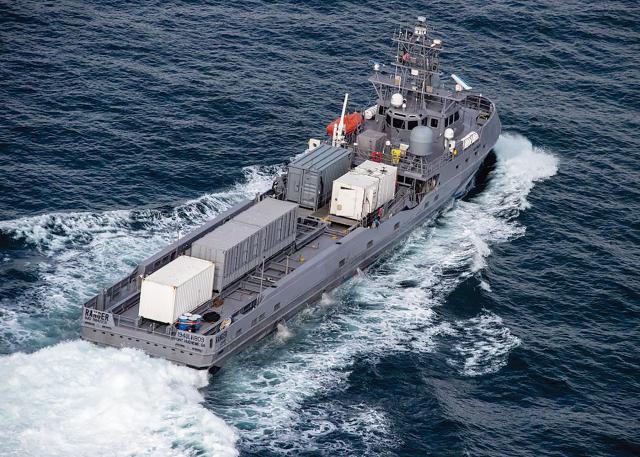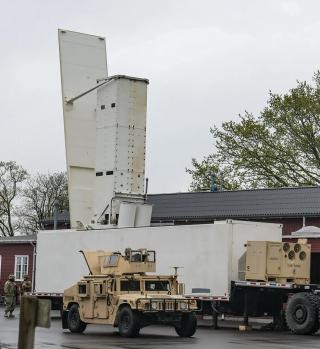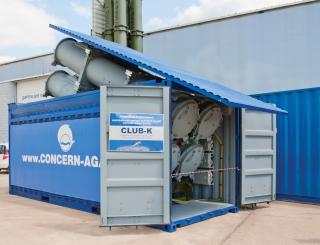In the modern era, where conventional warfare is expected to be conducted mostly at long range with missiles and drones, the aircraft and ships that deliver those missiles and drones to the theater of conflict aren't themselves terribly important. And, some of them that are purpose built military vehicles, such as the B-52 bomber, and the littoral combat ship, are only marginally more capable than commercial transport aircraft and ships respectively.
In the case of ships, the missile launchers, radar systems, drone launcher and support systems, and even guns that distinguish a warship from a merchant ship, can all be put in shipping containers and are pretty much ready to go. And, increasingly, since many advocates for a stronger navy are fixated on quantity rather than quality, putting these militarizing shipping containers on large numbers of merchant ships can quickly increase the quantity of missiles that the navy can deliver.
Surface combatant warships are inherently vulnerable, but at least securing most of their offensive capabilities at low cost with small crews mitigates the cost in money, and in crews placed in harm's way, of existing destroyers and frigates in the U.S. Navy.
Certainly, these ships would have some limitations. They don't have integrated advanced air defenses. They aren't well suited to littoral warfare where small missile boats and short range naval drones and ground based anti-ship missiles can easily place them in harm's way. They don't have torpedoes or naval guns or anti-submarine warfare or mine countermeasures. But, they do perform the most critical mission for "near peer conflicts" of providing platforms for the delivery of anti-ship and land attack long range missiles (and even anti-ballistic missile air defenses) and long range reconnaissance drones, from stations deep in the blue seas of international waters.
On the other hand, given their narrow mission, it isn't at all obvious why it doesn't make more sense to hand the task of delivering long range anti-ship and land attack missiles over to long range aircraft that can spend a bare minimum of time "in theater" exposed to enemy missiles and aircraft, with a minimum number of crew in harm's way, and remove low and vulnerable naval ships from this mission all together. Long range aircraft can also be rapidly shifted from one theater of action to another across the globe, in a matter of days, in the event of simultaneous regional wars, while ships take weeks to make that transition. This is essentially the U.S. Air Force's argument for a large B-21 fleet.
Really the only blue sea navy mission that can't be dealt with this way is the task of locating opposition submarines, which can be delegated to small drones with a purely reconnaissance mission directed from a small number of motherships, with the actual strike mission being something that could be carried out, for example, by P-8 maritime patrol aircraft (or a wide variety of other air platforms).
The days when noisy diesel submarines just below the surface have to be attacked with torpedos from destroyers should be left back in the days of World War II. And, there simply aren't all that many military submarines in the world, fewer still are in the fleets of potential adversary nations (predominantly North Korea, China, Russia, and Iran), and only China and Russia have significant military submarine capabilities that extend far from their coasts. Russia's navy, moreover, is in a low state of readiness as Russia's military diverts available resources to fight the Ukraine War. So, rather than thinking in the abstract, it is essential to realize that the number of blue sea military submarines deployed at any one time, which come from just two military forces and are split between multiple theaters of potential conflict, is small. And, while they are hard to find, they are comparatively easy to destroy once located, as they have far fewer active defenses than surface warships against anti-submarine missiles.
In the past half decade, innovators have heeded calls to increase the Navy’s ship count by putting containerized missiles on merchant ships. They have improved the weapons, drones, and sensors to the point the Navy is experimenting with mounting them on container ships. Even so, U.S. politicians, military leaders, and analysts continue to overemphasize the number of destroyers, cruisers, frigates, etc., the Navy needs. But the Navy has acknowledged it cannot meet its goal of 380-plus ships any time soon: In October 2024, Deputy Chief of Naval Operations for Warfighting Requirements and Capabilities Vice Admiral James Pitts noted that, if the budget is kept at the projected level, that number would be unobtainable.Even were the Navy to get the desired 380-ship fleet, there would not be sufficient forward-deployed ships to win a missile fight within range of the antiship missiles of the People’s Liberation Army (PLA). Yet staying out of range of Chinese missiles would render the surface fleet largely irrelevant and leave allies to fight without U.S. naval support. If war comes, China will almost certainly fire first, leaving U.S. forces to absorb the opening volley and hoping to remain effective enough to reply. As has been well documented elsewhere, carrier-based aviation’s limited range and land-based aircraft’s vulnerabilities mean strike fighters probably would not be much help. Finally, the Navy has too few missiles to fill the magazines of the ships it has. There are many reasons for this, but a significant factor is that the Navy’s budget and expenditures continue to emphasize expensive platforms and missiles rather than affordable ones.In short, the need for and potential capability of the missile merchant concept and new weapons have each increased dramatically in the past six years. The clear solution is to put more ships to sea with better missiles and drones. It is time to get on with it.
Different (Better) WeaponsThe number of ships is the wrong metric. Far more important is how many weapons the Navy can bring to bear in a great power confrontation. Retired Navy Captain Wayne Hughes highlighted a fundamental truth about modern naval combat: “Navies are in a new tactical era characterized by missile warfare.” Recent events suggest attack drones should be added to the calculations.Multiple nations and even private companies are exploring the potential of this idea and have developed complete packages of containerized systems that include a variety of missiles, drones, guns, radars, towed-array sonars, and command-and-control suites. Russia has been selling the Club-K antiship missile in 20-foot equivalent (TEU) containers for more than a decade. Since then Israel, Iran, China, the United States, the Netherlands, Denmark, and numerous other nations have developed containerized missile systems. This year, the Royal Netherlands Navy began arming its auxiliaries with containerized missiles. Israel’s tests of containerized weapons in 2020 is instructive:No modifications to the ship would be required once the weapon system is on board. In addition to offensive missiles, cargo ships could be equipped with canisterized and/or concealed anti-ship missiles and guns, as well as air- and missile-defense interceptors and sensors—making them asymmetric, concealable warships.Containerized weapons and support equipment are multi-modal. They can be used from container ships or the decks of warships or even moved ashore. Containers can be handled by commercial equipment present in any major port, including those throughout the first and second island chains. Marine littoral regiments and Army multidomain task forces are already exercising with land-based antiship cruise missiles (ASCMs) in the Pacific. The next logical step would be to move from the specialized launchers and vehicles those services are using now to standard shipping containers and commercial trucks to make the systems interchangeable and multimodal.Unfortunately, China’s large merchant marine fleet and tens of thousands of fishing vessels could provide the PLA Navy (PLAN) with effectively unlimited launch platforms. This makes it all the more important that the United States and regional partners cooperate. Japan, Taiwan, South Korea, Singapore, and Australia are already fielding land-based ASCMs that could easily be adapted for containerized systems. Such efforts would reinforce U.S. efforts to protect friends and partners in the East and South China Seas and beyond.
Improved Attack and Surveillance SystemsA model of a containerized Kratos XQ-58 unmanned aerial vehicle. KratosThe range and capability of air and sea drones have increased massively in recent years. For example, conservationists have been using autonomous drones with visual and infrared sensors and very long range—up to 1,100 miles for the Flexrotor—to monitor illegal, unreported, and unregulated fishing as well as wildlife poaching.Israel has been operating the Harpy unmanned aerial vehicle (UAV) for more than a decade. The vertical-takeoff-and-landing Harpy can autonomously navigate up to 600 miles to hunt in the visual, infrared, and electromagnetic spectrums.
The U.S. Air Force, Navy, and Marine Corps are experimenting with the Kratos Valkyrie UAV. It has a range of 3,000 miles, a payload of 600 pounds, and a cruise speed of .72 Mach, and it is designed to be “runway independent.” Kratos has developed a version with a launcher that can fit in a standard shipping container.Numerous countries are developing long-range autonomous surface attack boats. Ukraine’s Magura V has demonstrated lethal capability and essentially driven the Russian Navy from the Black Sea. Saronic Technologies, a U.S. firm, is building autonomous, swarming boats with a 1,000-mile range and a 1,000-pound payload. These craft are small enough that several can be loaded in a TEU container. They can be launched from a ship at sea, aircraft, and the beach.
Inexpensive PlatformsBy combining such new weapons and delivery systems with widely available and relatively inexpensive commercial ships, the Navy could create a class of “missile merchants” that would possess deep magazines, long range, and onboard intelligence, surveillance, and reconnaissance (ISR), thus addressing the number and range issues. Further, it would be easy to upgrade the capabilities of these ships. As the Navy develops newer, longer-range missiles, drones, and sensors, it could swap out the containers.Ship costs could vary from a low of $10 million for a small container ship to $40 million for a 40,000 deadweight-ton (DWT) container ship. With missile, drone, command-and-control, life-support, and maintenance containers, such a ship could be converted into a warship with long-range precision weapons faster than designing and building a new warship. A package with 40 missiles would cost around $100 million—about $2 million for each Naval Strike Missile and $20 million for command, maintenance, and living modules and any minor ship modifications required. Most modern container ships are double hulled, making them capable of absorbing more damage than Navy surface ships such as littoral combat ships. In addition, empty containers could be filled with foam, dirt, or other energy-absorbing materials as inexpensive armor. As an added benefit, container ships generally require less maintenance than surface warships and are at sea much more frequently.For a net acquisition cost of $130 to $145 million each, the Navy could purchase 40 or so missile merchants for about one-quarter the combined cost of a Gerald R. Ford–class aircraft carrier and its air wing—while adding 1,600 high-end missiles to the fleet.Better still, this concept could reinforce the significant progress the Pentagon is making in seeking nontraditional defense firms to produce low-cost cruise missiles. In mid-2024, just 11 weeks after its founding, startup defense company Ares began flight testing a cheap cruise missile. It “is targeting a $300,000 unit cost for its missiles,” compared with the $3 million Long-Range Antiship Missile.The Navy has test fired containerized SM-6 Standard Missiles from the large unmanned surface vessel Ranger. U.S. Navy (Tyler Fraser)Smaller, cheaper ASCMs like these would mean the Navy could greatly increase the fleet’s magazine depth, fill the vertical launch systems cells of its current fleet, and potentially put hundreds of missiles on board missile merchants.Beyond reduced up-front costs, real savings also would occur in manpower. Based on peacetime manning plus additional personnel for combat systems operation, missile merchants would require about 45 sailors. In other words: Four could be manned for the expected crew size of the future Constellation (FFG-62). Containerized launch-control modules could be assigned to Navy Reserve units that could routinely train on them during drill weekends. Those units’ annual training then could consist of operating the modules on board proof-of-concept ships—or even leased ships, if necessary. Such training could help identify the optimal mix of regulars, reservists, and merchant mariners. Wargaming and simulation also would help determine the optimal missile, attack drone, and ISR drone loadout per ship.It would be essential that the Navy resist any bureaucratic impulse to require these ships to be retrofitted to meet Naval Sea Systems Command general specifications. Doing so would dramatically increase the cost and complexity.A positive second-order effect of acquiring missile merchants could be to provide command opportunities for younger officers, restoring the long and successful Navy tradition of putting young officers in command. A missile merchant would be an ideal first command for a lieutenant commander.
Getting Under WayA Navy containerized missile launcher during an exercise in Bornholm, Denmark, in May 2024. U.S. Navy photo (James S. Hong)The Navy could begin the developmental process by purchasing existing containerized weapon systems and buying or leasing two container ships—a large ship of 30,000 to 40,000 DWTs with a 2,500-container capacity and a smaller ship of perhaps 6,000 DWTs with a 150–250 container capacity. This would allow initial experiments with different operating concepts.Some questions the Navy might consider include: Can these platforms provide deep magazines for destroyers operating outside the range of most Chinese weapons? Can commercially available, long-range drones establish ISR and communication networks to allow the ships to provide their own targeting information? Can larger drones such as the XQ-58A operate from these platforms and recover ashore at a Marine Corps expeditionary base for reuse?Communication systems would be an integral part of the containerized weapon packages on board missile ships. The recent adoption of Starlink/Starshield by various navies and commercial fleets is demonstrating that any ship can have high bandwidth, gaining rapid access to national assets and intensive commercial satellite surveillance of the planet. With sustained communications, the embarked weapons’ long ranges would allow massed fires from dispersed platforms—supporting the Navy’s distributed maritime operations concept. But degraded or even denied communications would not render the missiles useless. Inexpensive vertical-launch-and-recovery drones such as the Flexrotor or V-Bat would give the ships organic surveillance assets, allowing them to locate and engage targets even when communication links to higher headquarters are severely degraded. With clear commander’s intent and containerized sensors, the ships would stay in the fight, increasing the uncertainty China would face if it were to initiate a conflict.The Navy should work with innovative companies to develop rapid mobilization and production processes. It should even consider something like the Civil Reserve Aircraft Fleet, which subsidizes commercial aircraft purchases on the condition that, in times of war, those aircraft could be mobilized by the Department of Defense. A Civil Reserve Industrial Base to subsidize advanced manufacturing could provide surge capacity in a future crisis while investing in innovation immediately.As concepts are refined, the Navy could buy as many as eight merchant ships for the price of one frigate to develop tactics and integrate these missile merchants into fleet fires. As a bonus, in peacetime, these ships could supplement Military Sealift Command, moving matériel into and around operational theaters.
Ready and WaitingRussia has been selling the Club-K container missile system for more than a decade. ShutterstockOne certain effect of any war between the United States and China would be a rapid and dramatic reduction in maritime trade for the duration. With proper testing and development ahead of time, the Navy could be well positioned to replace significant combat losses with idle container ships and arm them with containerized weapons and sensors. They would be able to provide rapid reinforcements—but only if the Navy starts working with manufacturers now while training Naval Reserve crews to man the mobilized ships.Advanced Chinese antiaccess systems will limit how far forward the fleet can deploy until China’s fleet and missile arsenal are degraded. Pushing carrier strike groups too far forward could place too much blood and treasure in harm’s way without contributing to the fight. Carriers would play a vital role in winning the midocean fight for dominance but are too valuable to risk in the opening stages.In contrast, missile merchants would be low-value platforms of the type historically put at risk in great power conflict—consider the picket ships that screened the U.S. fleet during the Battle of Okinawa. In any naval fight some ships will have to be risked but, unlike those picket ships, missile merchants would pack a considerable offensive punch while being much tougher and needing smaller crews. And, given that electromagnetic sensors could have a hard time distinguishing them from what commercial ship traffic remains at sea, they might be more likely to persist forward.Converted merchant ships could be durable and inexpensive weapon “trucks.” Given modern containers’ interchangeability, this type of missile ship could become the most easily replaced and upgraded system in a fight.
From here.
In other, not entirely unrelated news, China has finally put into service long range, nuclear armed capable strategic bombers that can refuel in the air:
China’s military has begun deploying significant numbers of upgraded strategic nuclear bombers that are bolstering Beijing’s triad of weapons, including land-based missiles and nuclear missile submarines, according to U.S. defense officials.The new strategic bomber is an H-6N that was recently converted to a nuclear delivery system from less-capable bombers. . . .What sets the H-6N apart from earlier variants is that it’s the first bomber in the Chinese warplane inventory that can be refueled while in flight. “This is important because if you want to have a strategic strike capability, you have to have strategic range associated with that, and [the H-6N] is designed specifically to deliver a nuclear payload,” the official said.The Chinese nuclear bomber force is being built along lines similar to those used by the Soviet and now Russian nuclear bomber force, the official said. The number of deployed H-6Ns is unknown as the Chinese government does not disclose the size of its nuclear forces. The Arms Control Association estimates there are about 20 H-6Ns. Other assessments from 2023 state that the total number of H-6 bombers of all variants is around 150, with a projected expansion to around 250 bombers by 2035.The H-6N has a range of 3,728 miles and can be armed with an air-launched ballistic missile with a range of 1,864 miles for a combined nuclear strike range of 5,592 miles.China did not use the new H-6N variant during a provocative aerial incursion near Alaska last summer. Two H-6K maritime bombers along with two Russian Tu-95 Bear nuclear-capable bombers conducted an operation in international airspace July 24, penetrating the Alaska air defense identification zone and prompting the deployment of U.S. F-35 and F-16 jets and Canadian CF-18 fighters to intercept them. It was the first time Chinese and Russian bombers operated together and highlights the potential for nuclear war fighting cooperation under the 2022 “no limits” agreement. “Both the Chinese and Russian bombers involved in the patrol were nuclear-capable, a signal that corresponds with the rapid expansion of China’s nuclear forces and persistent Russian nuclear saber-rattling,” the Center for Strategic and International Studies said in a report on the joint bomber patrol.Both H-6 variants are based on the Soviet Tu-16 heavy bomber, dubbed the “Badger” by NATO and first flown in 1952. Analysts say the Chinese probably flew H-6Ks rather than the newer H-6N near Alaska to avoid showing off the strategic bomber to U.S. intelligence assets. . . .The Pentagon’s annual report on the Chinese military, published in December, said the PLA enhanced the effectiveness of the H-6 despite its age. Both variants can fire long range cruise precision missiles capable of hitting ships near Chinese coasts from airfields in China, while the H-6K can carry six supersonic long-range YJ-12 anti-ship cruise missiles.“The H-6N features a modified fuselage, enabling it to carry an air-launched ballistic missile externally that may be nuclear-capable,” the report said. . . . A new H-20 stealth strategic bomber is on the drawing board, the report said.




No comments:
Post a Comment